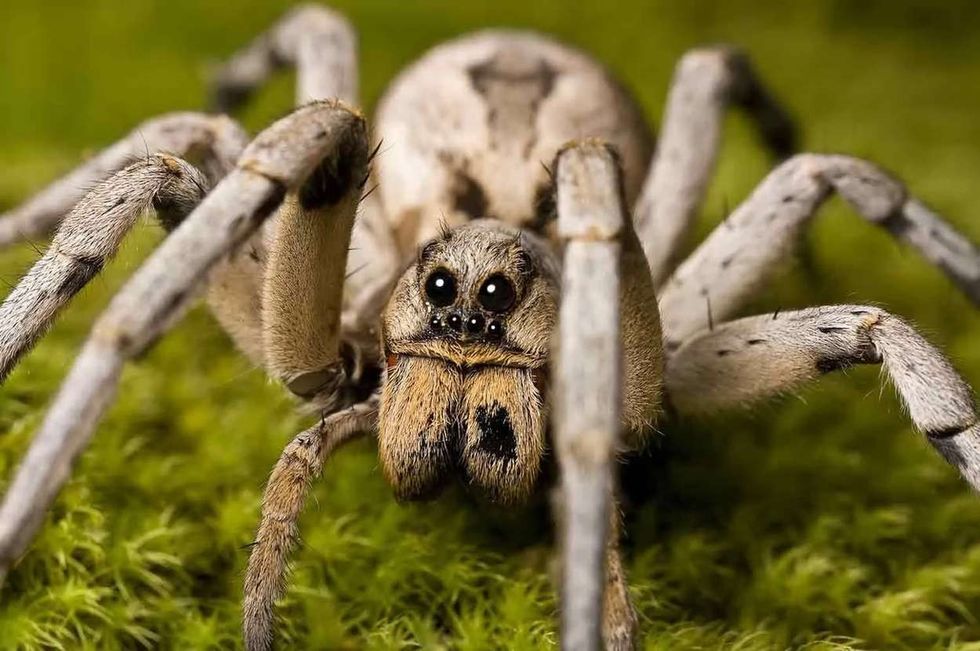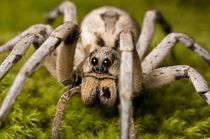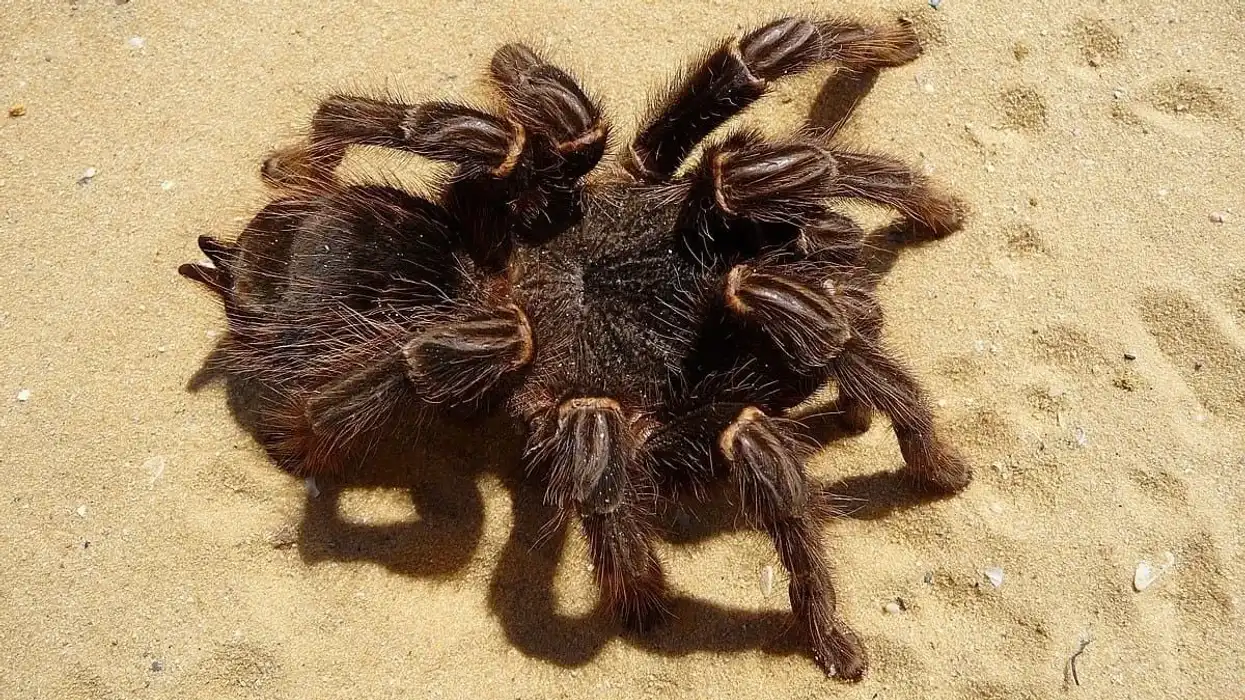Wolf spiders are one of the most common spiders among all the spiders that we see every day. With two large prominent eyes on their head, they can be pretty distinguishable.
Some of them can also be recognized by the egg sac they carry around with them. So, if you're looking for them, look for these features in the spiders you see.
Plus their habitats range from the cold of mountains to the hotness of the lava tubes to the harshness of many deserts and also in your backyard. So, you can just go out at night in your garden with a light and you might find one or two of them running around looking for prey.
Their prey also involves unwanted insects. So, there's no harm if they're around, and don't worry about the bite either, because they're not lethal.
There is no shortage of these little creatures. In the United States too, so much so that one of the states put a specific species of wolf spiders as the official spider of the state. Read ahead to know about which state and more information on these little wonders.
If you like this article, then take a look at the yellow sac spider and the six-eyed sand spider.
Wolf Spider Interesting Facts
What type of animal is a Wolf Spider?
Wolf spiders are a group of spiders that are members of the family, Lycosidae. They are a huge group of spiders that include approximately 2500 species who can live just about anywhere in the world.
What class of animal does a Wolf Spider belong to?
The members of the wolf spider family are a part of the Arachnida class of animals.
How many Wolf Spiders are there in the world?
Wolf spiders are one of the most common groups of spiders out there and with so many different species of these spiders in the world, the exact number of these little creatures is unknown.
Where does a Wolf Spider live?
Like most other spiders, wolf spiders can also adapt to their surroundings and they do live just about everywhere in the world other than Antarctica and deep in the ocean. These little speedsters wander around.
They can be found inland or coastal in both places. Mainly in forests, deserts, wetlands, grasslands, households or in your garden too.
Some species of wolf spiders also live in some of the most remote and inhospitable areas, such as lava tubes.
So whether you're living in the desert, or in the cold of the mountains, or maybe somewhere near an active volcano, chances are, you'll find a group of these spiders as your neighbors. One of the most common species among them is the rabid wolf spider, which lives in North America.
What is a Wolf Spider's habitat?
Wolf spiders can live in almost any type of place in the world, except the cold of Antarctica. But some species within this group can live in the cold of the mountains.
Most of the species live in burrows in the ground, lined with silk, while they hunt for prey in the vicinity of these burrows. Some find their shelter under rocks or leaves or whatever nature may provide for them as most of these spiders don't spin a web for their living.
Female wolf spiders live a certain amount of time in these burrows after she has laid her eggs. Many of them live in shrubs and gardens around human households.
Who do Wolf Spiders live with?
Most wolf spiders tend to live alone. Considering some of the species live in such remote places, it's pretty natural that they live on their own. But some among the group can also be found in households and near locality. So, they do know how to live among humans too.
How long does a Wolf Spider live?
Compared with other common spiders, wolf spiders live a shorter amount of time. Most of them live less than one year. Some may live up to 18 months or so but that's pretty uncommon.
How do they reproduce?
The mating season for the wolf spiders comes mainly in the fall.
The courtship ritual varies a little as wolf spiders include so many different species of spiders.
But mainly the male wolf spiders beat the front of their legs and palps in a drumming way on the ground or wave them up in the air, which might attract the female wolf spiders, but a lot of factors work before the female or male choose their partners.
After the mating, the female spider stays in an enclosed space to lay her eggs and stays in the burrows of their male partner for a while.
The male wolf spider on the other hand leaves the female alone from there on.
After the hatching of the eggs, the female then wraps them up in a silk egg sac. The most distinct feature of these spiders is that the females carry these egg sacs around, stuck to their abdomen till it's time to hatch.
Once they've hatched, the baby wolf spiders attach themselves to their mother and stay with her until they're ready to live on their own.
What is their conservation status?
The wolf spiders spend most of their lives hunting for prey and breeding. The breeding usually happens in a huge amount of numbers. So the conservative status of the spiders is of the least concern. Only the Kauai cave wolf spider and the Deserta wolf spider are currently endangered.
Wolf Spider Fun Facts
What does a Wolf Spider look like?

Most of the wolf spiders are fuzzy or hairy, grey, dark brown or mottled colored spiders. But mainly wolf spider's size and color depends a lot upon their habitat as they usually camouflage themselves according to their surroundings.
Most of the spiders of other species have a flashy kind of appearance, but not this group of spiders and that's only for the reason of camouflaging themselves. They have eight eyes in their head like most other spiders.
Their eyes are in three rows. But what differentiates them the most are their two large eyes, which also makes them see better, which are in the middle row.
The uppermost row has two middle-sized eyes and there are four other small eyes in the lowermost row. Most of these spiders have eight legs.
How cute are they?
With their fuzzy appearance, two large eyes and as some of them are also large in size, they may come across as scary to some people. But the wolf spiders are not at all harmful unless disturbed. And they live all around us. So, they might not always seem cute but why not give them a chance?
How do they communicate?
Some of these spiders use vibrations, some also use their vision as most wolf spiders have strong eyesight. Some even use scent and smell.
Their courtship ritual varies in many ways, such as some use their purring vibrations to attract the female wolf spiders, some wave their palp and forelegs in the air or in a drumming way on the ground.
How big is a Wolf Spider?
Wolf spiders are normally the same in terms of size as other generally common spiders, which is 0.24 in-1.37 in (0.6 cm - 3.5 cm) in length.
Some species among this group are a little bigger than the others, like the Deserta wolf spiders, whose length can even be up to 1.6 in and can be found in Deserta Grande Island of the Madeira archipelago, or the Carolina wolf spider, which is the largest among all wolf spiders in the North American region.
How fast can Wolf Spiders move?
Wolf spiders are one of the fastest of all spiders. As they are very agile and such athletic creatures, these are actually the sprinters among all the spiders. At the most, wolf spiders have a speed of 0.6 m/s, which is quite fascinating despite the fact that they are not large in size.
How much does a Wolf Spider weigh?
The exact weight of the wolf spiders is unknown but it's somewhat under 0.0625 lb.
What are their male and female names of the species?
There are no specific names for the male or females of the species.
What would you call a baby Wolf Spider?
Baby spiders are called hatchlings or spiderlings for all species.
What do they eat?
The wolf spiders are basically carnivores, whose diet includes grasshoppers, crickets, ants, small insects or animals, including other spiders. Some wolf spiders that are big in size even hunt small reptiles or amphibians.
These spiders can survive when their surrounding environment produces a scarcity of food. This is because wolf spiders can slow down the metabolism of their own body.
Are they harmful?
Wolf spiders are not harmful to humans, not unless they are disturbed. They're usually a shy group of spiders. Wolf spiders are certainly not the most poisonous spider. A wolf spider bite is not lethal to people but if bitten, you should definitely go see your doctor for that spider bite treatment.
Would they make a good pet?
People can certainly keep wolf spiders as pets and it's also quite easier to keep them as they need very little tending to and they're definitely not poisonous spiders. As the wolf spiders like dark, they should be kept in such a place and will just need to be provided with food and water.
They only bite if they come across something that is strange to them, so try not to engage with them too much.
Did you know...
The scientific name of wolf spiders, Lycosidae, comes from the Greek word that means wolf.
The wolf spiders got their name for the way they hunt their prey. Wolf spiders wait in their burrows, hiding and waiting for their prey. They pounce on their prey like wolves when they're near. Hence, they got the name of wolf spiders.
These spiders have excellent eyesight along with their distinctively large eyes compared with other spiders.
South Carolina, in the United States, was the first state that picked a state spider, which is the Carolina Wolf Spider.
They are good for the environment and sometimes for your households too as they eat most of the unwanted insects, including spiders.
How do their webs work?
Most spiders spin webs to catch their prey but as the spiders of this group don't hunt for their prey in such a way, most of the species don't spin webs at all. Only the mothers spin egg sacs after laying eggs.
How to get rid of Wolf Spiders?
They're not the most venomous spider but it's better to get rid of them if they're living under your roof. These spiders like the dark and they live under rocks or leaves, in shrubs and grasses too.
So, exposing your household to more light, making your house clutter-free and cutting down dense grass can be helpful. It's recommended to not kill the spiders as sometimes some of them might carry spiderlings that might get released in the process.
Here at Kidadl, we have carefully created lots of interesting family-friendly animal facts for everyone to discover! Learn more about some other arthropods including six eyed sand spiders and Brazillian wandering spiders.
You can even occupy yourself at home by drawing one of our wolf spider coloring pages.









